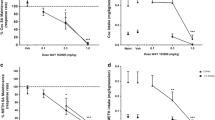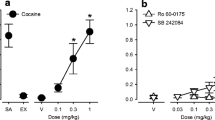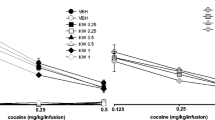Abstract
The central nervous system (CNS) of the rat is known to contain serotonin (5-HT) type -3 receptors (5-HT3). Behavioral evidence suggests that 5-HT3 receptors interact with mesolimbic dopamine (DA) systems and that 5-HT3 antagonists can interfere with the hyperlocomotive effects of amphetamine and cocaine and the rewarding and stimulus effects of morphine, nicotine and ethanol. Cocaine, which blocks the reuptake of DA, norepinephrine (NE), and 5-HT in the CNS, also may be an antagonist at 5-HT3 receptors. The purpose of the present study was to determine whether systemic administration of the 5-HT3 antagonists ICS 205930 or MDL 72222 could mimic or block the discriminative stimulus properties of cocaine. Once rats (N=16) were trained to discriminate cocaine (10 mg/kg) from saline, substitution tests with various doses of cocaine (0.313–10 mg/kg), ICS 205930 (2–24 mg/kg), and MDL 72222 (2–16 mg/kg) were conducted. Cocaine produced a doserelated increase in cocaine-appropriate responding while the 5-HT3 antagonists engendered primarily saline-lever responding. Neither ICS 205930 nor MDL 72222 were able to antagonize the stimulus effects of cocaine (5 mg/kg). Response rates were not significantly reduced when the 5-HT3 antagonists were given in combination with cocaine. The results indicate that although 5-HT3 antagonists can inhibit some of the unconditioned behavioral effects of psychomotor stimulants, the discriminative stimulus effects of cocaine remain intact.
Similar content being viewed by others
References
Blandina P, Goldfarb J, Craddock-Royal B, Green JP (1989) Release of endogenous dopamine by stimulation of 5-hydroxytryptamine 3 receptors in rat striatum. J Pharmacol Exp Ther 251:803–809
Bradberry CW, Roth RH (1989) Cocaine increases extracellular dopamine in rat nucleus accumbens and ventral tegmental area as shown by in vivo microdialysis. Neurosci Lett 103:97–102
Butler A, Hill JM, Ireland SJ, Jordan CC, Tyers MB (1988) Pharmacological properties of GR38032F, a novel antagonist at 5-HT3 receptors. Br J Pharmacol 94:397–412
Callahan PM, Appel JB, Cunningham KA (1991) Dopamine D1 and D2 mediation of the discriminative stimulus properties of cocaine. Psychopharmacology 103:50–55
Carboni E, Acquas E, Leone P, Perezzani L, DiChiara D (1988) 5-HT3 receptor antagonists block morphine- and nicotineinduced place-preference conditioning. Eur J Pharmacol 151:159–160
Carboni E, Acquas E, Leone P, Perezzani L, DiChiara D (1989) Differential inhibitory effects of a 5-HT3 antagonist on druginduced stimulation of dopamine release. Eur J Pharmacol 164:515–519
Costall B, Domeney AM, Naylor RJ, Tyers MB (1987a) Effects of the 5-HT3 receptor antagonist, GR38032F, on raised dopaminergic activity in the mesolimbic system of the rat and marmoset brain. Br J Pharmacol 92:881–894
Costall B, Domeney AM, Naylor RJ, Tyers MB (1987b) Inhibition by 5-HT3 antagonists of hyperactivity caused by dopamine infusion into rat nucleus accumbens. Br J Pharmacol 93:194P
Costall B, Domeney AM, Jones BJ, Kelly ME, Gerrard PA, Naylor RJ, Tyers MB (1988) Influence of GR38032F on the behavioral consequences of ceasing subchronic treatment with drugs of abuse. Br J Pharmacol 95:905P
Cunningham KA, Dworkin SI, Smith JE (1991) Neurobiology of cocaine: reinforcing and stimulus effects. In: Lakoski JM, Galloway MP, White FJ (eds) Cocaine: pharmacology, physiology and clinical strategies. Telford Press, New Jersey
Fozard JR (1984) MDL 72222: a potent and highly selective antagonist at neuronal 5-hydroxytrptamine receptors. Naunyn-Schmiedeberg's Arch Pharmacol 326:36–44
Fozard JR, Mobarok Ali ATM, Newgrosh G (1979) Blockade of serotonin receptors on autonomic neurones by (-)-cocaine and some related compounds. Eur J Pharmacol 59:195–210
Grant KA (1990) The discriminative stimulus effects of ethanol and 5-HT3 mediated neurotransmission. Pharmacologist 32:130
Hagan RM, Jones BJ, Jordan CC, Tyers MB (1988) Effects of the 5-HT3 receptor antagonist, GR38032F, on the synthesis and metabolism of 5-HT and dopamine in rat forebrain. Br J Pharmacol 95:867P
Hagan RM, Jones BJ, Jordan CC, Tyers MB (1990) Effect of 5-HT3 receptor antagonists on responses to selective activation of mesolimbic dopaminergic pathways in the rat. Br J Pharmacol 99:227–232
Jiang LH, Ashby Jr. CR, Kasser RJ, Wang RY (1990) The effect of intraventricular administration of the 5-HT3 receptor agonist 2-methylserotonin on the release of dopamine in the nucleus accumbens: an in vivo chronocoulometric study. Brain Res 513:156–160
Kilpatrick GJ, Jones BJ, Tyers MB (1987) Identification and distribution of 5-HT3 receptors in rat brain using radioligand binding. Nature 330:746–748
Koe BK (1976): Molecular geometry of inhibitors of the uptake of catecholamines and serotonin in synaptosomal preparations of rat brain. J Pharmacol Exp Ther 199:649–661
Moghaddam B, Bunney BS (1989) Differential effect of cocaine on extracellular dopamine levels in rat medial prefrontal cortex and nucleus accumbens: comparison to amphetamine. Synapse 4:156–161
Oakley NR, Jones BJ, Tyers MB, Costall B, Domeney AM (1988) The effect of GR38032F on alcohol consumption in the marmoset. Br J Pharmacol 95:870P
Persoutka SL (1988) 5-Hydroxytryptamine receptor subtypes. Ann Rev Neurosci 11:45–60
Richardson BP, Engel G, Donatsch P, Stadler PA (1985) Identification of serotonin M-receptor subtypes and their specific blockade by a new class of drugs. Nature 316:126–131
van der Hoek GA, Cooper SJ (1990) Evidence that ondansetron, a selective 5-HT3 antagonist, reduces cocaine's psychomotor stimulant effects in the rat. Psychopharmacology 101: S59
Author information
Authors and Affiliations
Rights and permissions
About this article
Cite this article
Paris, J.M., Cunningham, K.A. Serotonin 5-HT3 antagonists do not alter the discriminative stimulus properties of cocaine. Psychopharmacology 104, 475–478 (1991). https://doi.org/10.1007/BF02245652
Received:
Revised:
Issue Date:
DOI: https://doi.org/10.1007/BF02245652




